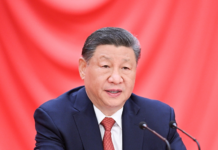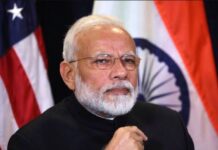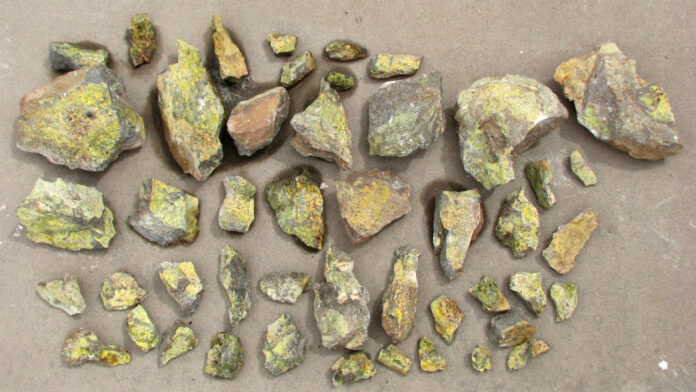Amid the raging pandemic in the southern Indian state of Maharashtra, the anti-terrorism squad arrested on May 6, two persons (Jagar Jayesh Pandya and Abu Tahir Afzal Hussain Choudhry) for attempting to sell seven kilograms of highly radioactive uranium for a price of about Rs 210 million. The “gentlemen” had advertised the proposed sale online.
As such, the authorities initially dismissed the advertisement as just another hoax. They routinely detained the “sellers-to-be” and forwarded a sample of their goods to the Bhabha Atomic Research Centre. They were shocked when the Centre reported that “the material was natural uranium”. As such the squad was compelled to book the duo under India’s Atomic Energy Act, 1962, at Nagpur police station.
The event, though shocking, is not one of its kind. Earlier, in 2016 also, two persons were arrested by the Thane (Maharashtra) police while they were trying to sell eight to nine kilograms of depleted uranium for Rs 240 million. It is surmised that sale of uranium by scrap dealers in India is common. But, such events rarely come in limelight.
According to Anil Kakodar, former chairman of the Atomic Energy Commission, `Factories using uranium as a counterweight in their machines are mandated to contact the Atomic Energy agencies and return uranium to them. They however resort to short cuts and sell the entire machine with uranium in scrap’.
The Indian media scarcely reports such incidents. However, the Indian government sometimes reports such incidents to the International Atomic Energy Agency (IAEA) to meet disclosure requirements. According to international media reports on 25 February 2004, India reported 25 cases of “missing” or “stolen” radioactive material from its labs to the IAEA. Fifty-two percent of the cases were attributed to “theft” and 48 percent to the “missing mystery”. India claimed to have recovered lost material in 12 of 25 cases. It however admitted that 13 remaining cases remained mysterious.
India reports such incidents to the IAEA to portray itself as a “responsible state”. It is hard to believe that radioactive material could be stolen from nuclear labs without operators’ connivance.
Nine computers, belonging to India’s Defence Research and Development Organisation establishment at Metcalfe House, New Delhi, were stolen. India communicated 25 cases of ‘stolen or missing’ uranium to the IAEA. In different incidents, uranium in varying forms and quantities continue to be recovered from scrap dealers and others by Indian authorities. The recoveries include 57 pounds of uranium in rod form, eight kilograms in granular form, two hundred grams in semi-processed form, besides 25 kilograms in radioactive form, stolen from the Bibi Cancer Hospital.
The ‘thieves’ also stole three cobalt switches, worth Rs. 1.5 million, from the Tata Steel Company laboratory at Jamshedpur (Jharkhand). A shipment of beryllium (worth $24 million), was caught in Vilnius, on its way to North Korea. Taiwanese authorities had intercepted a ship carrying dual-use aluminum oxide from India to North Korea. New Jersey-based Indian engineer Sitaram Ravi Mahidevan was indicted for having bypassed US export procedures to send blueprints of solenoid-operated valves to North Korea.
The Taiwanese authorities had intercepted a ship, carrying dual-use aluminum oxide from India to North Korea. It is an essential ingredient of rocket casings and is, as such, prohibited for export to “rogue” countries.
Despite recurrent incidents of theft of uranium or other sensitive material from Indian nuclear labs, the IAEA never initiated a thorough probe into the lax security environment in government and private nuclear labs in india. However, the international media has a penchant for creating furore over uncorroborated nuclear lapses in Pakistan. A US magazine had reported that some uranium hexafluoride cylinders were missing from the Kahuta Research Laboratories. Pakistan’ then information minister and foreign-office spokesman had both refuted the allegation..
Similarly, Professor Shaun Gregory in his report The Security of Nuclear Weapons contends that those guarding about 120 nuclear-weapon sites, mostly in northern and western parts of Pakistan, have fragmented loyalties. As such, they are an easy prey to religious extremists.
The ‘research work’ by well-known scholars reflects visceral hatred against Pakistan. The findings in fresh ‘magnum opuses’ are a re-hash or amalgam of the presumptions and pretensions in earlier-published ‘studies’. It is time that the West deflected its attention to India where movements of nuclear materials, under the 123 expansion plan, are taking place between nuclear-power plants sprawling across different states.
Frederick W. Kagan and Michael O’Hanlon, also draw a gloomy portrait of the situation in Pakistan. In their article in The New York Times in November 2007, and predicted that extremists would take over, if rule of law collapses in Pakistan. Those sympathetic with the Taliban and al-Qaeda may convert Pakistan into a state sponsor of terrorism. They pointed to Osama bin Laden’s meeting with Sultan Bashiruddin Mahmood and Chaudhry Abdul Majeed, former engineers of Pakistan’s Atomic Energy Commission (having no bomb-making acumen).
They claimed that US military experts and intelligence officials had explored strategies for securing Pakistan’s nuclear assets. One option was to isolate the country’s nuclear bunkers. Doing so would require saturating the area, surrounding the bunkers, with tens of thousands of high-powered mines, dropped from air, packed with anti-tank and anti-personnel munitions. The panacea, suggested by them, was that Pakistan’s nuclear material should be seized and stashed in some “safe” place like New Mexico.
The pilloried Pakistani engineers had no knowledge of weaponisation. The critics mysteriously failed to mention that Pakistan is a party to the UN Convention on the Physical Protection of Nuclear Materials. The steps taken by Pakistan to protect its nuclear materials and installations conform to international standards. The National Command Authority, created on 2 February 2000, has made failsafe arrangements to control development and deployment of strategic nuclear forces.
Pakistan’s nuclear regulatory authority had taken necessary steps for safety, security, and accountability of Pakistan’s nuclear weapons, facilities, and materials even before the 9/11 incident. These controls include a functional equivalent of the two-man rule and permissive action links (PALs). The indigenously-developed PALs are bulwarks against inadvertent loss of control, or accidental use of weapons. So far, there has been no security lapse in any of Pakistan’s nuclear establishments.
Abdul Mannan, in his paper titled “Preventing Nuclear Terrorism in Pakistan: Sabotage of a Spent Fuel Cask or a Commercial Irradiation Source in Transport”, has analysed various ways in which acts of nuclear terrorism could occur in Pakistan (quoted in Pakistan’s Nuclear Future: Worries beyond War). He has fairly reviewed Pakistan’s vulnerability to nuclear terrorism through hypothetical case studies. He concludes that the threat of nuclear terrorism in Pakistan is a figment of imagination, rather than a real possibility.
There are millions of radioactive sources used worldwide in various applications. Only a few thousand sources, including Co-60, Cs-137, Ir-192, Sr-90, Am-241, Cf-252, Pu-238, and RA-226, are considered a security risk. The Pakistan Nuclear Regulatory Authority (PNRA) has enforced a mechanism of strict measures for administrative and engineering control over radioactive sources from cradle to grave. It conducts periodic inspections and physical verifications to ensure security of the sources. The Authority has initiated a Five-Year National Nuclear-Safety-and-Security-Action Plan to establish a more robust nuclear-security regime. It has established a training centre and an emergency-coordination centre, besides deploying radiation-detection-equipment at each point of nuclear-material entry in Pakistan, supplemented by vehicle/pedestrian portal monitoring equipment where needed.
Fixed detectors have been installed at airports, besides carrying out random inspection of personnel’s luggage. All nuclear materials are under strict regulatory control right from import until their disposal.
Concluding remarks
Nuclear controls in India and the USA are not more stringent than Pakistan’s. It is not understood why the media does not deflect their attention to the fragile nuclear-security environment in India. It is unfortunate that the purblind critics fail to see the gnawing voids in India’s nuclear security.
The ‘research work’ by well-known scholars reflects visceral hatred against Pakistan. The findings in fresh ‘magnum opuses’ are a re-hash or amalgam of the presumptions and pretensions in earlier-published ‘studies’. It is time that the West deflected its attention to India where movements of nuclear materials, under the 123 expansion plan, are taking place between nuclear-power plants sprawling across different states.
Above all, will the international media and the IAEA look into open market uranium sales in India?























